PURPOSE This study aimed to verify the accuracy of three-dimensional (3D) motion data produced through artificial intelligence-based user motion recognition technology with images obtained using a smartphone monocular camera. This was done to explore the possibility of developing an application that can improve the reliability of the measurement of physical activity performing motions and feedback provision. METHODS To check the accuracy of the artificial intelligence-based 3D motion analysis system that utilized a semi-supervised learning method, a commercialized 3D infrared motion analysis system measured and compared motions on three movement planes, motions with limited joint movement, and fast motions in a wide moving range. RESULTS The motions on the coronal and sagittal planes produced through the 3D motion analysis application showed very high measurement accuracy; however, the accuracy of the measurement of motions on the horizontal plane, which could not be measured directly with a camera, was relatively lower than that of the coronal and sagittal planes. Accuracy in measuring 3D motion was moderate in moving motions and low in motions with limited joint movement. CONCLUSIONS For the developed 3D motion analysis system to be used in online physical education, the types of physical activities included in the program should be comprehensively composed through the analysis of the content system of the physical education curriculum and the resultant physical activities.
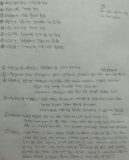
Values, such as development and social responsibilities, are added on victory-oriented Korean sport. Those change of values are along with discussions regarding improvement of players’ training environment, however, discussions on improvement of players’ training environment so far rather focused on ideological concepts, such as players’ holistic human development and human rights, therefore, there was a lack of discussion on practical training methods or teaching methods. This study focused on mental coaching as a specific method for improvement of players’ training environment. Mental coaching provides players with performance enhancement, personal growth, and self-actualization utilizing mental training, consulting, and mentoring in their training processes. This study examined a possibility of introduction of mental coaching as a training camp method for players by creating a training camp reflected on mental coaching perspectives and verifying the program effects of application. First of all, a mental coaching training camp was created through consultations with mental coaches, supervisors, and coaches. Goals of the mental coaching training camp were development of competition-routines, establishment of competition-circumstance coping strategies, comprehension of elite-players’ psychological resources, goal-setting, and motivation and the program consist of badminton competitions, mental education, a special lecture by an Olympic gold medalist, tracking, and sharing. The mental coaching training camp proceeded with middle and highschool badminton players and 31 coaches during three-days and four-nights. As results, the training camp was effective for players’ performance enhancement, personal growth, and self-actualization and team coaches realized a necessity of improvement in terms of their training and teaching behaviors. In other words, mental coaching training camp played a role as a source of long-term change as well as short-term results, thus, this study verified that the mental coaching can be introduced as a training camp method. It is anticipated that this study can provide sport fields and academic sport areas with an opportunity to consider both training contents and methods when it comes to discussion players’ training environment development.

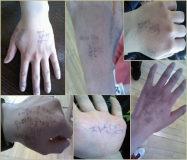
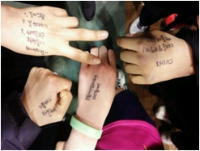

To provide the distribution of cardiorespiratory fitness including Bruce treadmill exercise time and estimated peak oxygen uptake (VO2peak) and investigate association with cardiorespiratory fitness and metabolic syndrome, sedentary lifestyle, or education level among Korean adults. Analysis of data on 2,006 adults (19-64 yr) who had completed a maximal grade treadmill exercise test, from the Sports Institute of Sports Science Fitness Standards (KISS FitS) project 2014-2015. The mean maximal exercise time was 11’26’‘, 11’18’‘, 11’06’‘, 10’03’‘ and 8’51’‘ (minutes and seconds) for men 19-29, 30-39, 40-49, 50-59 and 60-64 years of age, respectively, for women, it was 9’49’‘, 9’09’‘, 8’42’‘, 8’01’‘ and 7’33’‘ for the corresponding age groups. The mean peak oxygen uptake was estimated as 42.3, 41.8, 41.2, 37.6 and 33.6 ml/kg/minute for men 19-29, 30-39, 40-49, 50-59 and 60-64 years of age, respectively, For women, it was 34.0, 31.8, 30.3, 28.0 and 26.4 ml/kg/minute for the corresponding age groups. A positive association between cardiorespiratory fitness level and education level was observed for both men and women. Furthermore, participants with sedentary lifestyle had a significantly lower cardiorespiratory fitness than participants with activity lifestyle. Finally, Men with moderate and high fitness level had 50% and 87% lower odds for the metabolic syndrome, and women had 48% and 50% lower odds for the metabolic syndrome, respectively, than the ones with low fitness level after adjustment for age, smoking, alcohol intake, and sedentary lifestyle. These results can be used to track future Korean assessments and to evaluated interventions. The differences in fitness status by education level, sedentary lifestyle or metabolic syndrome can also be used to develop health policies, program and educational services.

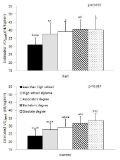
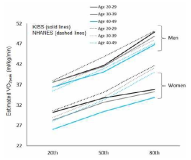
PURPOSE Through analysis, this study reports on occurrences of children and adolescents’ sports accidents and presents measures to prevent, cope with, and manage school sports accidents. METHODS The study used both quantitative and qualitative methods. First, a frequency analysis was conducted using 284,429 safety accident data of the School Safety and Insurance Association (SSIA). Second, the inductive analysis method was applied to in-depth interviews conducted with eight teachers. RESULTS , accidents are characterized as follows: 1) At the school level, accidents have increased significantly every year in a large proportion of elementary and middle schools. 2) The span of time spent on sports was large. 3) Accidents happened at playgrounds and auxiliary facilities. 4) Accidents happened during kindergarten play and ball sports in schools. 5) The descending order of days with the most accidents was Thursday, Tuesday, Friday, Wednesday, Monday, Saturday, and Sunday. 6) Rather than a certain month, accidents happened across the school semester. 7) Most accidents occurred from 10 a.m. to 2 p.m. Second, field teachers’ stories were categorized into the following topics. 1) School accidents can occur anytime, anywhere. Whether mild or serious, they still had the burden of inevitable accidents. 2) Required: were prompt response and handling by appropriate teachers; timely treatment and recovery cost support; also procedurally simplified handling by SSIA was helpful. 3) Avoiding accidents requires the following:: regular operation of safety education programs; daily promotion of teachers’ preventive observation and close guidance; and active role reinforcement of SSIA and policy support. CONCLUSIONS Finally, measures to prevent, cope with, and manage school safety accidents were proposed.
PURPOSE This study analyzed the relationship among coaching behaviors, motivational climate, sports competence, effort, and failure tolerance as perceived by high school athletes. Additionally, it examined whether motivational climate, competence, and effort mediate the relationship between coaching behaviors and failure tolerance. METHODS Using questionnaires measuring autonomy-supportive coaching behavior, controlling coaching behavior, motivational climate, sports competence, effort, and failure tolerance, 365 high school athletes were surveyed. Using SPSS 28.0 and Amos 28.0 software, descriptive statistics and structural equation modeling were conducted along with the following types of analyses: reliability, correlation, confirmatory factor, convergent validity, and discriminant. Additionally, the bootstrap method was used to verify serial multiple mediating effects. RESULTS Autonomy-supportive behavior had a significant positive effect 1) on motivational climate, sports competence, and effort and 2) on failure tolerance. 3) Controlling coaching behavior had a significant negative effect on motivational climate and sports competence. 4) Motivational climate and 5) sports competence both had a significant positive effect on effort. 6) Effort had a significant positive effect on failure tolerance. Last, in the relationship between autonomy-supportive behavior and failure tolerance, motivational climate, sports competence, and effort showed partial mediating effects. CONCLUSIONS This study confirms the importance of coaches’ autonomy-supportive behavior in determining failure tolerance among adolescent athletes. Based on this information, counseling (educational) programs aimed at enhancing performance can be developed and provided in sports settings, thus fostering success among athletes.
Purpose This study is to investigate the human rights violations of Semi-professional team athletes. Methods The subjects of the survey were 4,069 people in total of 56 sports athletes from teams. than, 1,251 athletes who agreed to provide personal information (635 males and 616 females) were sampled. The survey tool consisted of a total of 76 questions asking about violence, sexual violence, and general characteristics of semi-professional athletes. Results were frequency analysis, cross-analysis, and multiple response analysis. Results Despite being an adult athlete in the semi-professional Team's Workplace Sports Team, life controls were severe in the sports team and human rights violations, such as verbal and physical violence, were widely observed, and sexual harassment and sexual violence were not small. The main perpetrators were the leaders and senior players, and the venue was the training ground. The players were in an environment where they were forced to respond passively for fear of hierarchical, collective atmosphere and personal disadvantages, and were blind spots for labor rights in terms of contracts and treatment. Conclusion To human rights violations of semi-professional athletes as the structural problems of the Korean sports. It is necessary to strengthen human rights education by the workplace movement department and conduct regular human rights surveys, and legal institutionalization to establish a disciplinary information system for perpetrators. In addition, by enacting guidelines for human rights in the sports world, a system should be prepared so that the victims can actively express their intentions.

This study was to analyze the hierarchical importance of successful intelligence in Football coaches and players. In order to explore the hierarchical importance of successful intelligence 24 football coaches(under AFC A course) and 20 Korea Football Association U15 Players were responded to analytic hierarchy process questionnaires. In the Analytic Hierarchy Process, football coaches and players completed the AHP Questionnaire with creative intelligence, analytical intelligence and practical intelligence. The hierarchical importance order of successful intelligence for coach and player were analytical intelligence, practical intelligence, and creative intelligence respectively. Evaluation of hierarchical importance of successful intelligence for coach is analytical intelligence(.542), practical intelligence(.278), creative intelligence(.181) in order. Evaluation of hierarchical importance of successful intelligence for coach was analytical intelligence(.684), practical intelligence(.161), creative intelligence(.155) in order. The hierarchical importance of successful intelligence for coach and player were similar each other. Analytical intelligence, was evaluated most important factor for coach and player in successful intelligence. Successful intelligence is important issue for sport performance. More consider needs to Successful intelligence for sport psychology researchers.





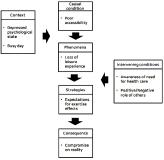
Purpose The purpose of this study is to investigate the alienation and the overcoming process of the physical activity participation of people with Adventitious Visual Impairment(AVI) Methods 21 Adults with AVI were recruited and one on one semi-structured interview was conducted. Ground theory was used to analyze the data. Member check, peer debriefing was conducted to enhance the trustworthiness of this study. Results As a result, a total of 203 concepts were derived. This consisted of 21 subcategories and the common themes of the subcategories were categorized into nine categories. Specific results are as follows. First, the physical activity of people with AVI was directly affected by the sports facilities, physical activity programs, and professional instructor. This causal condition resulted in the loss of leisure experience in the context of the busy daily life and the depressed psychological state. Second, due to the perceived need of health care and the positive involvement of others, people with AVI came to expect the effect of exercise. Third, people with AVI participated in physical activity again as a tool to achieve the purpose of health improvement. This type of physical activity has a limitation that it can not guarantee the continuity of physical activity due to the limitation that it does not contain autonomy and interest of people with AVI. Conclusions Based on these results, the following suggestions were made. First, it is necessary to improve the environment for ensuring participation in physical activity of people with AVI. Moreover education and promotion of the effects and values of the exercise should be carried out for people with AVI and their guardians. Second, it is necessary to diversify physical activity types and reconstruct existing exercise programs.
